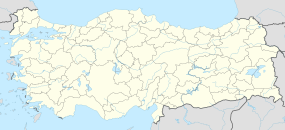Pessinus
| Πεσσινούς | |
| Location | Ballıhisar, Eskişehir Province, Turkey |
|---|---|
| Region | Phrygia |
| Coordinates | 39°20′2″N 31°35′4″E / 39.33389°N 31.58444°ECoordinates: 39°20′2″N 31°35′4″E / 39.33389°N 31.58444°E |
| Type | Settlement |
| History | |
| Periods | Hellenistic to Medieval |
| Site notes | |
| Condition | In ruins |
Pessinus (Greek: Πεσσινούς or Πισσινούς) was a city in Asia Minor, a geographical area corresponding today to modern Turkey on the upper course of the river Sangarios (Sakarya River), from which the mythological King Midas (738-696 BC?) is said to have ruled a greater Phrygian realm. However, archaeological research by Ghent University (1967–1973 under the directorship of Pieter Lambrechts; 1987–2008 under the directorship of John Devreker) showed that the city developed around 400 BC at the earliest, which contradicts any historical claim of early Phrygian roots. The investigations of the temple area, which was discovered in 1834 by the French explorer Charles Texier in the south of the village along the Gallos river, Angelo Verlinde's yet to be published 2012 PhD dissertation should greatly add to the understanding of the temple area.
As yet, the temple area (sector B) is the only thoroughly investigated area of the city, with the exception of the so-called Acropolis (sector I) near the northern entrance of the Ballıhisar valley. Since 2009, the city is being investigated by a team of the University of Melbourne, Australia, led by Gocha Tsetskhladze.
Pessinus, the present modern Turkish village of Ballıhisar is situated at 13 km from Sivrihisar a small town on the road Ankara- Eskişehir at the junction with the road to Afyon-İzmir, at 120 km SW of Ankara. The village is situated on the high Anatolian plateau at ca. 950 m altitude above sea level.It is developed in a valley, more specifically the tributary valley of the Sakarya (Sangarios) river.
According to ancient tradition, Pessinous was the principal cult centre of the cult of Cybele/Kybele. The Graeco-Phrygian Cybele is rooted in the old Anatolian goddess Koubaba whose cult spread over Anatolia during the second millennium BC. Tradition situates the cult of Cybele in the early Phrygian period (8th century BC) and associates the erection of her first "costly" temple and even the founding of the city with king Midas (738-696 BC?). However, the Phrygian past of Pessinus is still obscure, both historically as archaeologically. For example, Strabo (12.5.3) writes that the priests were potentates in "ancient times", but it is unclear whether Pessinus was already a temple state ruled by "dynastai" in the Phrygian period. According to Cicero (Har. Resp. 8.28) the Seleucid kings held deep devotion for the shrine which indicates the sanctuary was still much revered in this period.
...
Wikipedia

